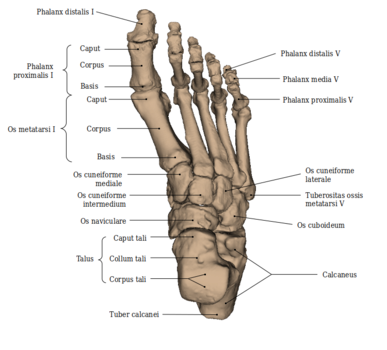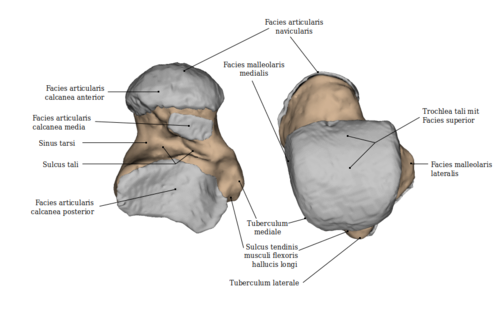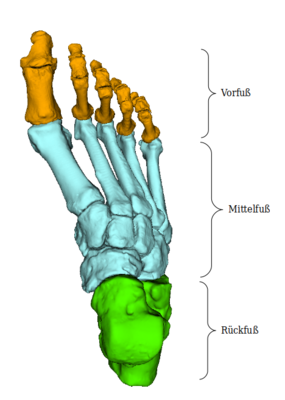Foot bones
Inhaltsverzeichnis
Function and tasks
The foot (Pes) has a particularly heavy task: it carries the entire body weight when walking and standing. It is one of the lower free limbs.
Muscles enable the movements of the foot. These include the short foot muscles and the long lower leg muscles. The muscles are also responsible for tensing the arch of the foot. The arch of the foot (longitudinal and transverse arch) allows body weight to be cushioned.
anatomy and structure
The foot is the lower part of the leg. The bony structure consists of a total of 26 bones, so almost 25% of all bones are in the foot.
The connection to the lower leg (fibula and shin) is made by the ankle joint. The upper side of the foot (dorsum pedis) is called the back of the foot, the lower side is called the sole of the foot (planta pedis).
Tarsal bones
The two ankles (malleolus) are formed by bone cones of the tibia or fibula. The root of the foot ( tarsus) lies between the lower leg and the metatarsus. It consists of seven individual bones.
[l[File:Calcaneus.png|right|500px|Foot: Calcaneus - left: View from plantar; right: view from dorsal]]
1. Calcaneus (Heel bone) The heel bone is the largest tarsal bone and the site of attachment for the Achilles tendon, the thickest and strongest tendon in the human body.
The Sinus tarsi is a tunnel-shaped channel formed between the calcaneus and the anklebone by two bone depressions (Sulcus calcanei and Sulcus tali). In this channel there are several ligaments which are important for the stability of the ankle joint.
2. Talus (Sprungbein) Das Sprungbein verbindet den Fuß mit dem Bein. Somit hat es die Aufgabe die durch das Körpergewicht entstehenden Kräfte auf das Fußgewölbe zu übertragen. Es bildet außerdem die Gelenkfläche zum oberen (Articulatio talocruralis) und unteren Sprunggelenk (Articulatio talotarsalis).
3. Os naviculare (Kahnbein) 4. Os cuboideum (Würfelbein) 5. Os cuneiforme laterale (laterales Keilbein) 6. Os cuneiforme intermedium (intermediales Keilbein) 7. Os cuneiforme mediale (mediales Keilbein)
Mittelfußknochen
Die Mittelfußknochen (Metatarsus) bestehen aus 5 Mittelfußknochen (Ossa metatarsi I-V):
Die Mittelfußknochen sind Röhrenknochen und am vorderen Ende über Gelenke mit den Zehen verbunden. Bei ihnen kann zwischen Basis, Corpus und Caput unterschieden werden.
Zehenknochen
Die Großzehe (Hallux) besteht aus zwei Gliedern (Phalanx proximalis und distalis), die übrigen Zehen aus drei (Phalanx proximalis, media und distalis). Die Phalangen proximales werden, wie die Mittelfußknochen, in Basis, Corpus und Caput unterteilt.
Einteilungen des Fußskeletts
Die Einteilung der Fußknochen erfolgt anatomisch und funktionell. Anatomisch wird in Antetarsus, Metatarsus und Tarsus unterteilt. Funktionell wird zwischen Vorfuß, Mittelfuß und Rückfuß unterschieden. Die 14 Zehenknochen bilden sowohl den Antetarsus als auch den Vorfuß. Der Metatarsus besteht aus den 5 Mittelfußknochen und der Tarsus aus den 7 Fußwurzelknochen. Der Rückfuß hingegen wird nur vom Fersen- und Sprungbein gebildet. Die restlichen Fußwurzelknochen und die Mittelfußknochen werden zum Mittelfuß gezählt.
weiterführende Links




